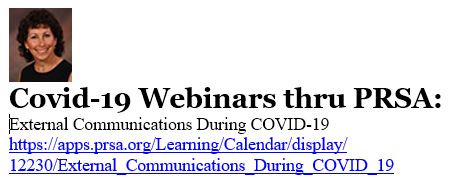
What is known about how humans process risk and crisis remind us that not every member of a stakeholder group is at the same point in their understanding, acceptance, processing or action steps. In fact, most are likely ricocheting daily, if not hourly, between these waypoints as they deal with the mental and emotional toll that the all-consuming change that is COVID19 has taken on their lives. Today they may feel positive and productive. Tomorrow they may not.
How we deliver the messages that need to be communicated, the words we use, and the environment in which messages are received must be carefully calibrated to resonate with our stakeholders. They must take into consideration their values and their current emotional state. They must be clear enough to motivate specific behaviors.
Thus, we move to the lowest common denominators when preparing communication:
- Use simpler, more direct language
- Elevate empathy
- Include doable action steps
Simpler, more direct language Write at a 7th or 8th grade level (see Flesch Reading Ease and Flesch-Kincaid Grade Level tests). Even the most educated have problems processing ideas when things are stressful or there is upheaval. Say what needs to be said in the simplest way possible – short words, short sentences, short paragraphs.
Elevate empathy Express shared emotions without telling them how they feel. “We are all anxious” is different then “We know you are anxious”.
犀利士台湾Doable action steps: Suggest something they can do as a result of your communication. “Make a donation”, “call a friend”, “read on our website” are all actionable ideas. With no call to action, your messaging is just a big “so what”. For example, COVID19 communication now has plenty of “calls to action”, including: “maintain a 6-feet-apart social distance when out in public”; “wash your hands for 20 seconds” and “stay at home unless you are an essential worker or you have to get gas, groceries or pharmacy items.”
In addition, don’t make stakeholders work to find your messaging or create additional “new” vehicles to communicate. That is just another stress on them. Use the channels they are comfortable with, used to using, and trust.
Finally, monitor the environment for ongoing changes that might make your communication insensitive if not offensive. This requires being flexible on how you choose to communicate and constantly monitoring the environment for potential message conflicts.
For instance, the cruise lines for too long continued to run ads and send mailing that promoting trips. The hotel industry was slow on the uptake as well. Some smaller organizations, perhaps being nimbler or more empathetic, switch gears faster e.g. Planet Fitness suspended monthly fees right away and ramped up their online platform to encourage continued activity. Compare that with Boston Health Club (see good reading on that one see Robin Schell’s last blog)!
Stay well!
Stacey Smith, APR, Fellow PRSA
Senior Counsel & Partner, Jackson Jackson & Wagner
